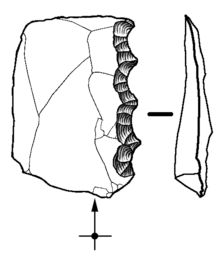Denticulate tool
In archeology, a denticulate tool is a stone tool containing one or more edges that are worked into multiple notched shapes (or teeth), much like the toothed edge of a saw.[1] Indeed, such tools have been used as saws, more likely for meat processing than for wood. It is possible, however, that some or all of these notches were used for smoothing wooden shafts or for similar purposes.

Drawing of tool with denticulate retouch
These tools are included in the Mousterian tool industry by Neanderthal culture, proceeded by small hand axes and side scrapers.[2]
References
- "Mousterian industry". Encyclopædia Britannica
- Picin, Andrea; Peresani, Marco; Vaquero, Manuel (2011). "Application of a new typological approach to classifying denticulate and notched tools: The study of two Mousterian lithic assemblages". Journal of Archaeological Science. 38 (3): 711–722. doi:10.1016/j.jas.2010.10.025.
Further reading
- Bordes, François (1961). "Encoches et denticulés". Typologie du Paléolithique ancien et moyen. Burdeos: Impriméries Delmas. pp. 35–36.
This article is issued from Wikipedia. The text is licensed under Creative Commons - Attribution - Sharealike. Additional terms may apply for the media files.